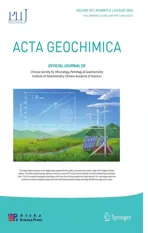Geochemistry and spectrometric prospection of younger granites and granitic pegmatites bearing uranium mineralization at G.Kab El Rakeb area,Central Eastern Desert,Egypt
2021-09-10GehadSalehBahaaEmadIbrahimAbdelKader
Gehad M.Saleh• Bahaa M.Emad• Ibrahim B.Abdel Kader
Abstract The present study deals with the detailed field geology,mineralogy,geochemistry,and spectrometric prospection of rare metals and radioactive minerals associated with granitic pegmatites in the Gabal Um Lassaf-Abu Dob-Um Atelia-Kadabora-Kab El Rakeb area(LDAKK),which are situated in the central Eastern Desert of Egypt.The study area is composed of granodiorites and monzogranites.The latter is dissected by granitic pegmatites with a discriminatory distribution of economically important mineralization(rare-metals and U–Th minerals).The granitic pegmatites display a zoning structure composed of feldspar-rich zones enveloping pockets of mica(mostly muscovite) and all zoning internal quartz core.Microscopically,the monzogranite and granitic pegmatites are composed of potash-feldspar,albite,and quartz with a small amount of biotite and muscovite.The mineralogical investigation of the highly radioactive zones in the granitic pegmatite shows enrichment in kasolite,uranothorite,thorite,xenotime,columbite,zircon,bismuth,and galena.Geochemically,the granitic pegmatites are enriched with high field strength elements(HFSE;Zr,Nb,Th,and U)and ion lithophilic elements(LILE;Rb,and Pb)and depleted in Ba,Sr,and Eu.They are strongly peralkaline to metalumainous except for two samples,which are peraluminous.They are formed by partial melting of metagreywackes at depth.The studied granitic pegmatites could belong to the NYF family (Niobium–Yttrium–Fluorine family) according to the geochemistry of the trace elements.The studied granitic pegmatites show deep negative Eu anomaly and display a strong M-type tetrad effect of rare earth elements.The field spectroscopy measurements showed the localization of the radiometric anomalous associated with the granitic pegmatites,which are intruded in the granitic host rocks.Their eU and eTh contents reached up to 316 and 1367 ppm,respectively.Uranium and thorium occurrences in the investigated granitic pegmatites are related to magmatic (syngenetic)origin with hydrothermal(epigenetic)input.The magmatic mineralization is evidenced by the occurrence of thorite and zircon,whilst the hydrothermal activity is represented by alteration of feldspars and formation of pyrite and iron oxides associated with the radioactive minerals.The high concentrations of uranium and rare metals mineralization in the investigated granitic pegmatites make them a target to exploration and to enlarge the potentiality of the highly mineralized zones.
Keywords Geochemistry · Gabal Um Lassaf-Abu Dob-Um Atelia-Kadabora-Kab El Rakeb area (LDAKK) ·Uranium · REE · Egypt
1 Introduction
Pegmatites are mainly igneous rock with a granitic composition (London 2008),which are characterized from the other igneous rocks by (1) the strongly coarse and consistently diverse size of its crystals,(2) an abundance of crystals with skeletal,graphic,or other extremely directional growth habits and (3) a prominent spatial zonation of mineral assemblages.
The enormous pluralities of pegmatites in the study area are granitic in composition,and this article exhorts to these rocks.Granitic pegmatites are noteworthy rocks by their spectacular appearance,diversity of radioactive,rare,and in many cases unusual minerals.They are distinguished by the ultimate enrichment of many rare elements such as Be,Li,B,F,P,Rb,Nb,REE(rare earth elements),Cs,Ta,Zr,Hf,Th and U and radioactive minerals (El Aassy et al.1997;Salem et al.1998;Heikal et al.2001;Cˇerny´ et al.2012).They are considered as primary sources of industrial minerals for the glass–ceramics and electronics industries and as a principal source of several important colored gemstones.Accordingly,the study of the granitic pegmatites and their associated economic minerals has attracted the attention of geologists in the last decades.They crystallize as products of residual solutions of granites,which are separated during the solidification of granitic magma (Makagon 2007).They are distinguished by an arranged sequence of mineral assemblages,by a marked size of the individual crystals,by the simultaneous crystallization of diverse mineral phases,and by enrichment of highly volatile components (Fersmann 1931).
Granitic pegmatites comprise considerable reservoirs of rare elements(Linnen et al.2012;Dill 2015).Rare element pegmatites are thoroughly known for their metal ores abundance and concentrations (Kudryashov et al.2017).They are either temporally related with peraluminous granites or granitic pluton occurring at depth.The relationship between rare element pegmatites and specialized granites is displayed by the pre-enrichment of rare-element parental granites.Most of the economically interesting rare-element pegmatites are Precambrian and are situated in high-temperature(T),low-pressure(P)greenschist belts,mainly the andalusite-cordierite-muscovite subfacies(Cerny 1982).
Granitic pegmatites are divided into three families regarding their rare metals content (Cerny 1991a;Fetherston 2004;Cerny and Ecrit 2005):A Niobium–Yttrium–Fluorine family (NYF);a Lithium–Cesium–Tantalum family (LCT) and a mixed NYF+LCT family.The NYF family is distinguished by higher Y,Ti,Sc,REE,Zr,U,Th,F contents and by Nb >Ta.They form from the fractionation from subaluminous to metaluminous A-and I-type granites that can be created through many processes which include reduced crust or mantle contributions (Cerny 2000).The LCT family is characterized by higher Be,Rb,Cs,Li,Sn,Ta,Nb B,P,and F contents and by Ta >Nb.They form from the fractionation of S-type granites and less commonly from I-type granites (Cerny 2000).The mixed NYF–LCT family is composed mainly of granites and pegmatites that exhibit mixed mineralogical and geochemical characteristics.
The occurrence and distribution of rare metals and radioactive minerals in Egypt are particularly prevailing in the post-orogenic granites and their related pegmatites (Abdel-Karim 1999;Abd El Naby and Saleh 2003).In several areas of the Egyptian Eastern Desert,radioactive granitic pegmatites were reported(Omar 1995;Ibrahim et al.1997,2001;Abu El-Ela and Salem 1999;Dawood 1999;Ali 2001;Heikal et al.2001;Yousef et al.2009;Asran et al.2013;Saleh et al.2019;Bahaa et al.2020).
The geology,structure,mineralogy,and geochemistry of the investigated area were studied by Fullager (1980),El-Mahallawi(1989),El-Sayed(1998),Abu El-Ela and Salem(1999),Ahmed (2002),Khaleal (2014) and Yousef et al.(2009).The occurrence and potential of rare metals and uranium in these rocks has not been determined and this study will give insights to that matter.The current study will give insight on the petrology,radioactivity and geochemical characteristics of the monzogranite and the granitic pegmatite hosting rare metals and uranium–thorium mineralization in Gabal Um Lassaf-Abu Dob-Um Atelia-Kadabora-Kab El Rakeb area (LDAKK) of the Central Eastern Desert of Egypt of the Arabian-Nubian Shield (ANS).
2 Geologic setting
2.1 Regional geology
The Arabian Nubian Shield (ANS) covers part of the widespread Pan-African orogenic belts in the northeast.It extends from Saudi Arabia and Egypt in the north to Ethiopia,Sudan,and Uganda-Kenya border in the south and as far as Somalia in the southwest.The Arabian Nubian Shield comprises an outcrop area of about 30–40 km2(Bentor 1985).The Arabian Nubian Shield is essentially grouped into two main parts namely the Arabian Shield and the Nubian Shield,separated by the opening of the Red Sea,some 25 million years ago.The Arabian-Nubian Shield was formed by accretion and assembly of oceanic and continental island arcs and has been affected by a major transcurrent fault system known as,the Najd shear zone (Moore 1979;Stern 1985).It experienced polyphase deformations,metamorphism up to amphibolite facies,and magmatic activity during the Pan-African tectono-thermal event (900–450 Ma:Stern et al.1988;Abdelsalam et al.2003;Fowler and El Kalioubi 2004).The Arabian-Nubian Shield in the Central Eastern Desert of Egypt consists of extensive outcrops of metamorphosed gneiss domes,ophiolitic-related assemblages island arc metavolcanics,and volcaniclastics association together with clastic molasse-type sediments.These rock assemblages were intruded by suites of mafic,syn-late to post tectonic volcanics,and granitoids.
The Pan-African event includes Western,Southern,and Eastern Africa and Saudi Arabia forming roughly a U-shaped orogenic area (Dixon 1979) of about 5000 km long,in which parts of the old African craton were remobilized,deformed,and metamorphosed,where the crust between these mobile belts remained stable cratonic areas.Kröner and Correia (1980) indicated that,the Pan-African tectonic regime was transitional between an older plate and a younger plate margin environment.Ressetar and Monrad(1983) described the Pan-African event as the incorporation of terrains of oceanic and island arc nature and subsequent post-tectonic plutonism.El-Gaby (1994) stated that,the Pan African belt in Egypt is divided into three segments of contrasting geologic features,being defined by two megashears;dextral NE-SW Qena-Safaga megashear and sinistral NW–SE Kom Ombo megashear.These features represent the first order conjugate shear system along which a large-scale displacement took place.
Based on lithologic distribution and tectonic style,the Egyptian basement rocks in the Eastern Desert and Sinai have been distinguished into three domains,the Northern Eastern Desert (NED),the Central Eastern Desert (CED),and the Southern Eastern Desert (SED),of Egypt (Stern and Hedge 1985;Habib 1987).The granitic rocks are the most common types among the Egyptian basement rocks(Stern and Hedge 1985) and constitute about 60% of the Eastern Desert basement outcrops.
The Egyptian granitic rocks have been classified according to (a) their relative ages into older and younger granites,(b) the apparent relation to orogeny to syn-late and postorogenic granites,(c) to the prevailing color and finally,(d) their type localities into shaitian-and gattarian granites.
2.2 Geology of the study area
The study area is situated between latitudes 25°25′and 25°35′N and longitudes 34°19′and 34°32′E in the central Eastern Desert of Egypt (Fig.1a,b).The study area is characterized by its moderate to low relief in the eastern parts adjacent to the Red Sea coast but the relief increases to the west.It includes G.kadabora batholiths in the center bounded by G.Umm Lassef (580 m.a.s.l) from the north and G.Um Battat from the south.G.Kadabora(635 m.a.s.l) batholiths comprise minor hills:G.Abu Ateila (840 m.a.s.l),G.Kab El Rakeb,G.Kadabora El Hamra and G.Abu Dob (460 m.a.s.l).The study area is intersected by several wadies:(a) W.Umm Greifat in the Northeast,(b)W.Umm Arrak in the East,(c)W.Kadabora in the South,(d)W.Kab El Rakeb in the center and(e)W.Um Geigh in the northwest.
Field investigation,as well as structural surveys,showed that the exposed rocks in the studied area are chronologically arranged from the oldest to youngest by serpentinites,metagabbros,ophiolitic me´lange,metavolcanics,older granites,monzogranites,and post granitic dykes and veins.
2.2.1 Serpentinites
The metamorphic assemblage is mainly composed of ophiolitic serpentinite and their derivate talc carbonates,which were tectonically thrust upon the island-arc calcalkaline metavolcanics and their related volcaniclsatics.At the southern part of the mapped area,the serpentinite and talc-carbonate interaction constitute the lenticular shape.They display cavernous form due to the weathering on both competent (ultramafic nodules) and are dissected by magnesite and calcite veinlets.These rocks are tectonically thrust over the surrounding schistose metavolcanics.
2.2.2 Metavolcanics
Metavolcanics are mainly exposed in the southern part of Kadabora El Zarqa.These rocks display low to moderate hills,ranging in color from dark green to grayish green color.They are massive,fine-grained,porphyritic,foliated,highly jointed and in some parts showing highly schistosity.They are basic,intermediate and acidic in compositions.The associated meta-pyroclastics are of minor occurrence and mainly represented by meta-agglomerates,banded meta-crystal tuffs and tuffs.
2.2.3 Older granites
The older granites (granodiorites) occupy the central part of the pluton(Fig.1b)and essentially consist of porphyritic granodiorite that gradually passes through a transitional zone into an equigranular granodiorite-monzogranite.The intruded granodiorite is characterized by spheroidal exfoliation weathering and forms low-lying outcrops dissected by large sandy wadis (Wadi Kab El-Rakeb).
2.2.4 Younger granites (monzogranites)
The monzogranites form the main pluton of G.Um Lassaf-Abu Dob-Um Atelia-Kadabora-Kab El Rakeb area(LDAKK),and are considered as one of the largest granitic outcrops in the Eastern Desert.The batholith is bounded at its northern peripheries by G.Umm Lassaf metavolcanics(Fig.1b).It has an oval to subrounded shape,roughly extending NE–SW with 21.5 km long and a width up to 14 km,covering an area of about 30–40 km2.The margin is characterized by its coarse and porphyritic grains,while the central parts of the batholith display coarse to equigranular grains.Alteration features such as sericitization,hematization,ferrugination,and silicification are locally affecting the granitic pluton(Fig.2a).The monzogranite is dissected by trachyte porphyries and basic dykes (Fig.2b)trending NE–SW,N–S,and NW–SE directions.The dyke swarms are of basic,intermediate and acidic compositions.Several granitic pegmatites occur as dykes and sills crosscutting the monzogranite of the (LDAKK) area(Fig.2c,d).
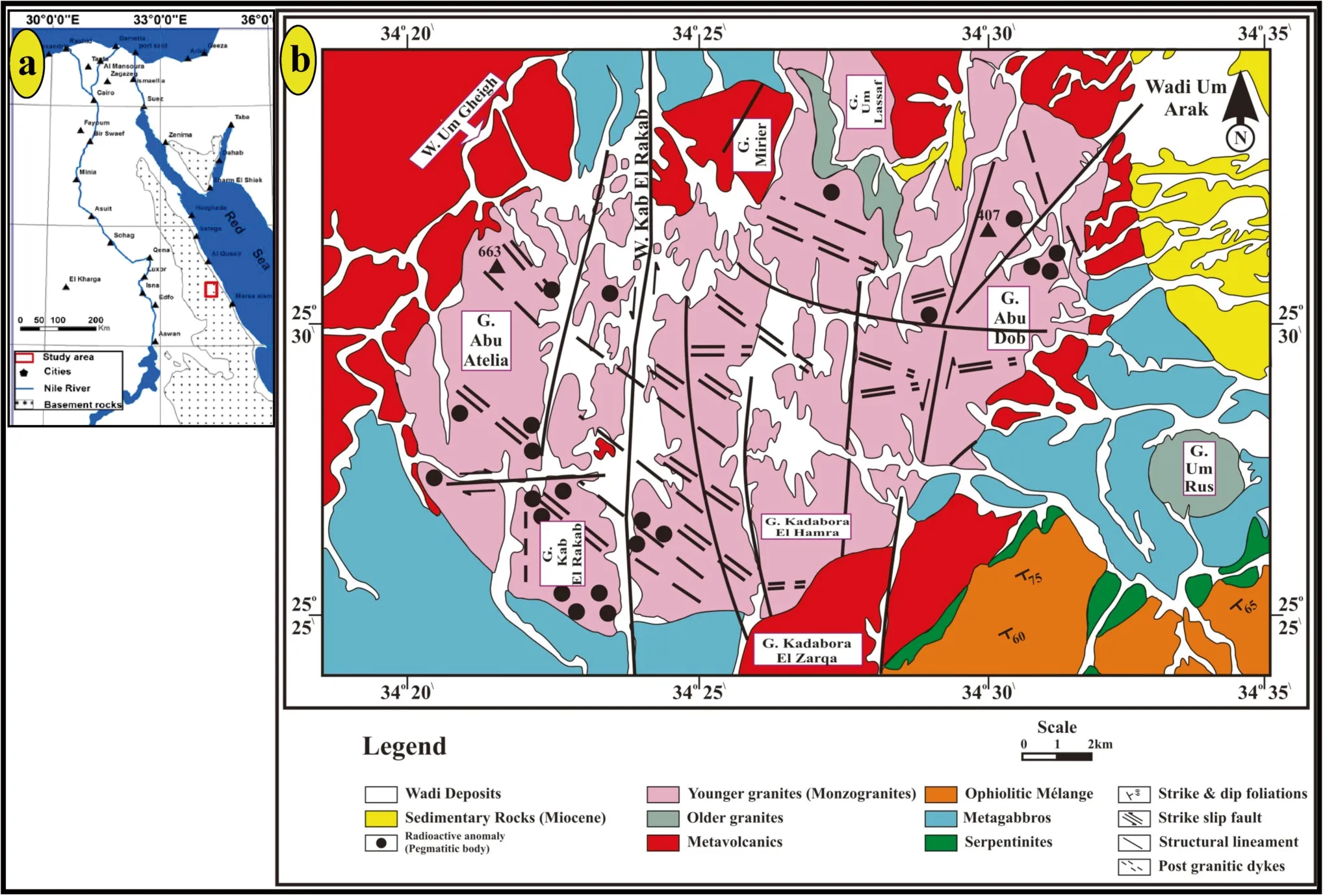
Fig.1 a Location map of the studied area and b Detailed geological map of Gabal Um Lassaf-Abu Dob-Um Atelia-Kadabora-Kab El Rakeb(LDAKK) area,Central Eastern Desert (CED),Egypt (Mapping by G.M.Saleh)
2.2.5 Granitic pegmatites
The granitic pegmatites are usually of the zoned type and occur as pockets (5 × 10 m) or vein-like bodies (Fig.2e)with quartz at the core followed by uranium mineralization(kasolite) and sometimes kaolinitized (Fig.2f).Pockets of the granitic pegmatites show a radial fabric of stretched augen quartz enclosing metamict zircon and columbite.Radial fibrous yellow secondary uranium mineralization is seen filling joints mainly trending NNW–SSW and ENE–WSW.The contacts between the monzogranite and granitic pegmatite bodies (pockets,veins,and dykes) are generally sharp,revealing their emplacement during the progressive solidification of the granitic magma.Some mineralization of uranium and columbite was recorded particularly with the feldspar of the uraniferous pegmatite.
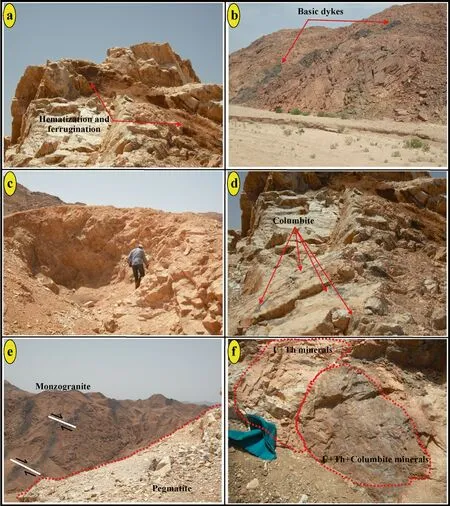
Fig.2 Field photographs of Gabal Um Lassaf-Abu Dob-Um Atelia-Kadabora-Kab El Rakeb (LDAKK) area,CED,Egypt showing: a Some alteration features such as hematization and ferrugination are affecting pegmatite pluton quarry (Looking NW),b Trachyte porphyry and basic dykes swarms cutting monzogranite (Looking NE),c Several pegmatite quarry with deep trench enveloping with radioactive minerals (Looking NE), d Pegmatite bodies occur as dyke enclosing radioactive minerals such as columbite with black color (Looking NE),e Sharp contact between pegmatites and monzogranites and the latter is dissected by basic dykes (Looking NW) and f Pegmatite bodies are usually of the zoned type and occur as pockets of uranium mineralization associated with columbite minerals (Looking NW)
2.2.6 Sedimentary rocks
Metamorphosed volcano-sedimentary rocks are also exposed in the investigated area as a narrow strip and include actinolite-graphite schist and biotite schist.They are fine-grained,highly sheared,intensively folded with dark grey with relics of graded-bedding.Their foliation planes dip 25°–55°outward the granitic mass of(LDAKK)and strike NE–SW,NW–SE,and ENE–WSW.
3 Methods and techniques
In the present study,fifteen thin sections from the studied monzogranites and granitic pegmatites were prepared for detailed petrographic investigations.The Monzogranites and granitic pegmatite samples weighing approximately2 kg,each was selected and prepared for mineralogical studies.Samples were firstly crushed and finally dried at 100 °C.The dried samples were separated using the bromoform liquid (heavy liquid of specific gravity 2.86) into two portions;the light portion (approximately 98% of the original sample weight) and the heavy portion (which contains the target minerals).Magnetic separation of the heavy portions was done using a Frantz Iso-dynam Magnetic Separator(Model LB1).The chemical composition of the separated minerals was tested using the Environmental Scanning Electron Microscope (ESEM,model Philips XL30)at the laboratory of the Nuclear Materials Authority.Twenty-five granitic pegmatite samples (15 samples from G.Abu Dob pegmatite and 10 samples from Kab El Rakeb pegmatite)were chosen from the highly mineralized zones and twelve samples from the monzogranites were crushed and then powdered using agate mortar.Major oxides and trace elements were analyzed for these samples using XRF(X-ray fluorescent spectroscopy),while rare earth elements were analyzed using ICP-MS (inductively coupled plasma mass spectrometry) at the commercial laboratory,Department of Earth Resources Engineering,Kyushu University,Japan,and analytical laboratories of the Nuclear Materials Authority and the data of the analyzed samples were reported in Tables 1,2 and 3 respectively.Field ground gamma-ray spectrometric survey was done using a wellcalibrated and high-sensitive model RS-230 spectrometer.This instrument is used to detect dose rate (D.R.) in a unit[nano sieverts per hour (nSvh -1)],potassium (K,%),equivalent uranium content (eU,ppm),and equivalent thorium content (eTh,ppm) on rock outcrops.
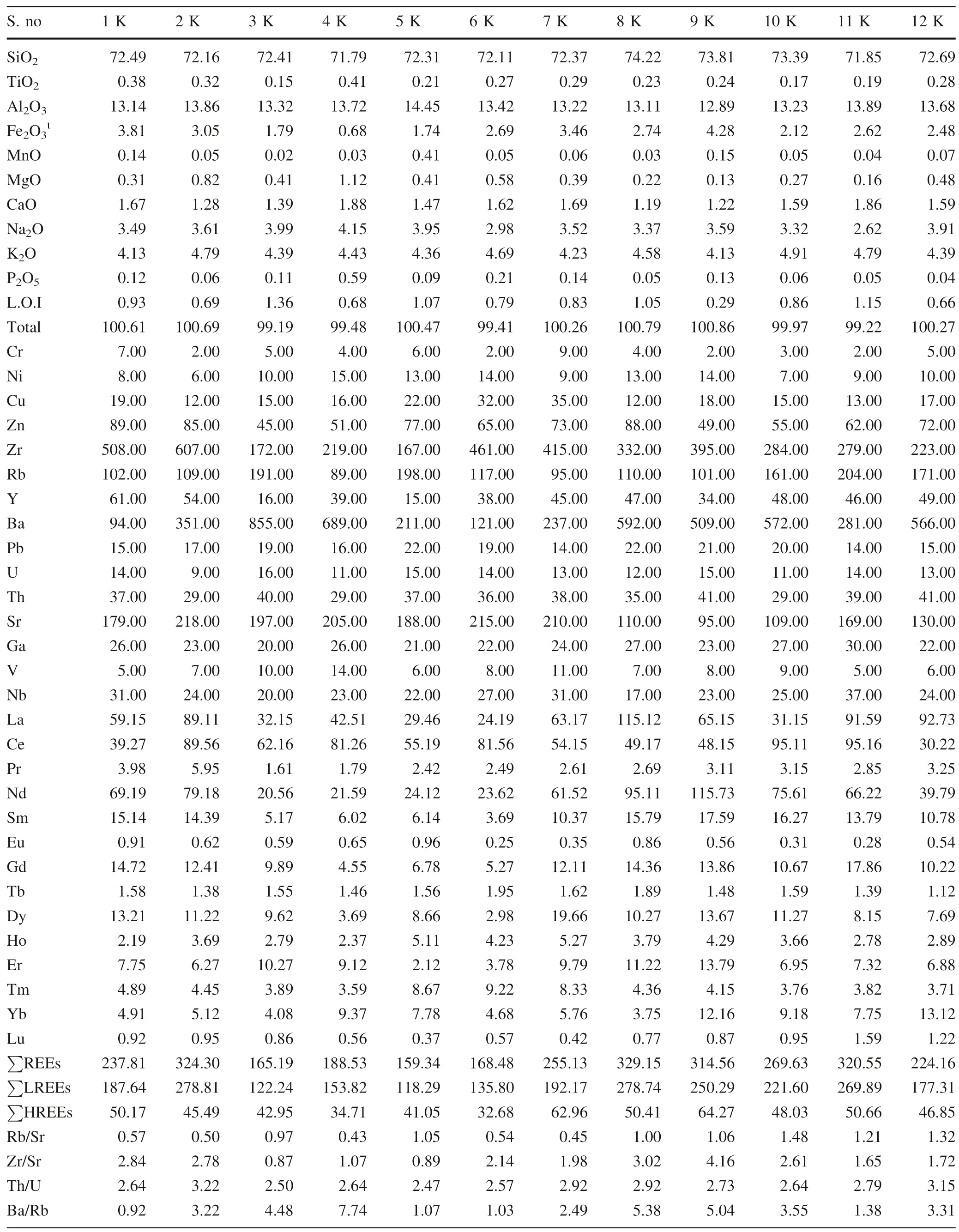
Table 1 Chemical composition of monzogranites from Kadabora pluton,CED,Egypt using XRF for major and trace elements analyses and ICPMS for REEs analyses

Table 1 continued
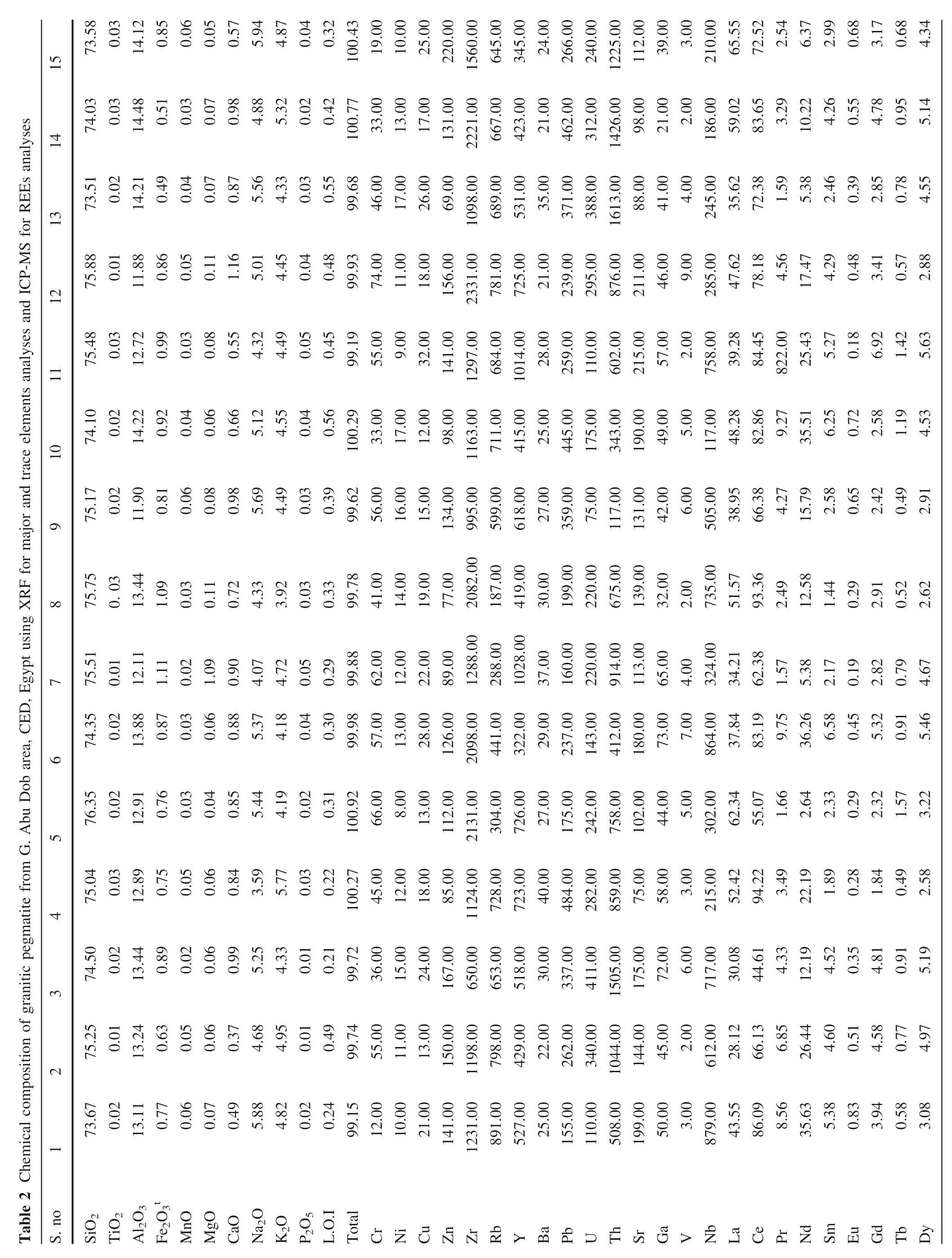
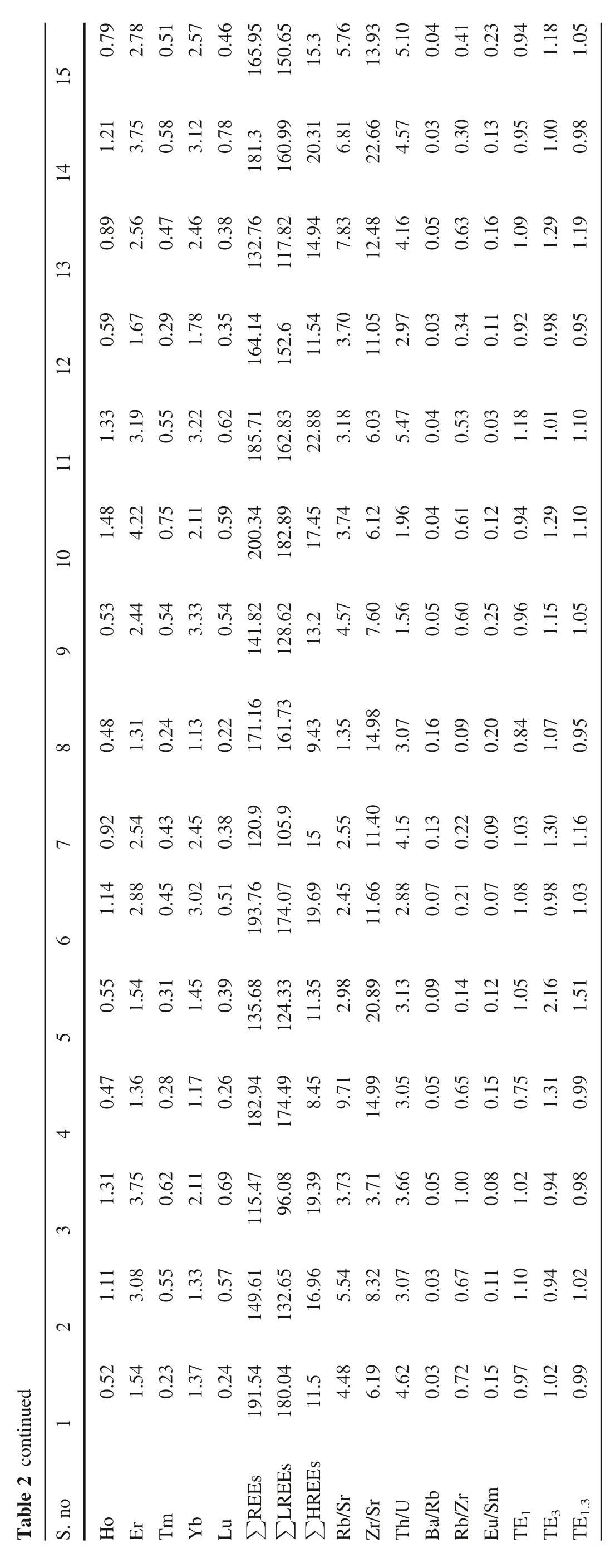
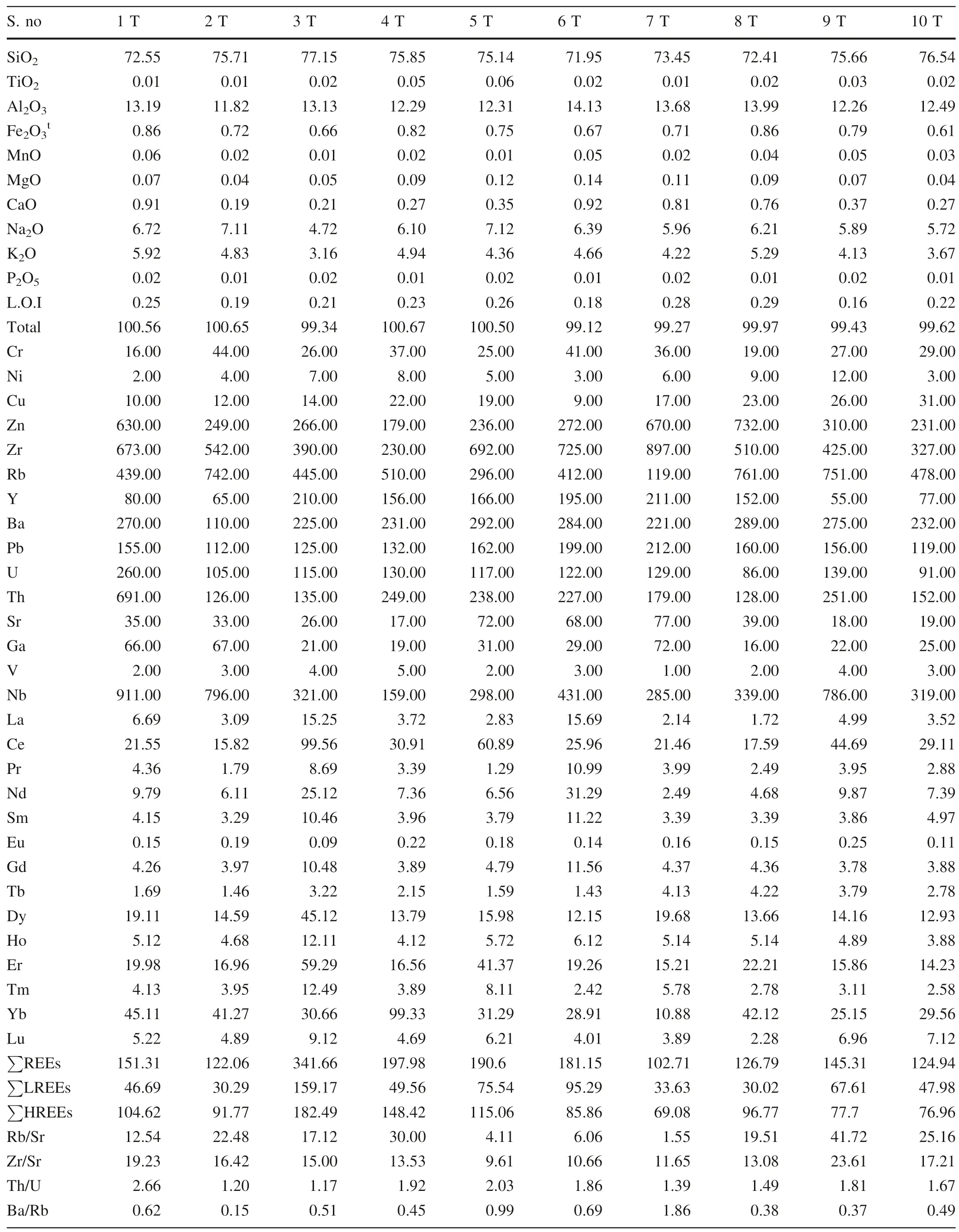
Table 3 Chemical composition of granitic pegmatite from Kab El Rakeb area,CED,Egypt using XRF for major and trace elements analyses and ICP-MS for REEs analyses

Table 3 continued
4 Results
4.1 Mineralogy of zoned pegmatites
In the majority of pegmatites,mineralogical and textural zonation is evident and has been recognized by previous workers.London (2008) described that pegmatite as a mainly igneous rock,characterized by extremely coarse but variable grain size,or by an abundance of crystals with graphic,or other strongly directional growth habits than other igneous rocks.In the present study of pegmatites,four main zones are indicated and described (Fig.3),(1)The outer or border zone is a chilled margin just inside the strong intrusive contact between pegmatite and monzogranite.The border zone is fine-grained and consists of quartz,muscovite,and albite,(2) The wall zone is usually less than around 3–4 m thick.The grain size is somewhere between that of the fine-grained border and that of the intermediate zone,where the largest crystals can be found.Albite,perthite,quartz,and muscovite are the main minerals.A common graphic intergrowth of perthite and quartz are present.This zone is characterized by the presence of tourmaline and beryl,(3) The intermediate zone between the wall and the core is distinguished by the presence of plagioclase,feldspars,micas,and quartz minerals.Various rare-element phases like beryl,albite,columbite-tantalite,pollucite,and lithium are also found.The grain-size is coarser than in the wall zone and (4) The core zone is essentially composed of monomineralic quartz and some perthite,albite,or lithium aluminosilicates.
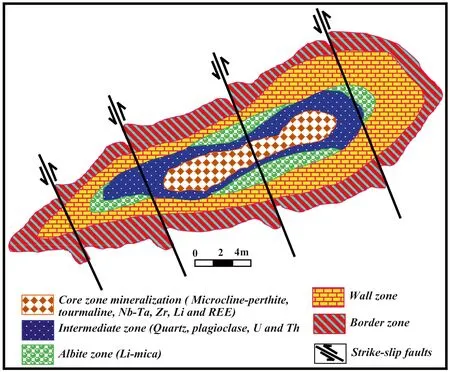
Fig.3 Simplified sketch geological map of Gabal Um Lassaf-Abu Dob-Um Atelia-Kadabora-Kab El Rakeb(LDAKK) area (modified after Schutte 1972;Cerny 1991a,1991b),showing the mineralogical zoning and structure of granitic pegmatites
4.2 Petrography
Monzogranite is massive,medium-to coarse-grained,buff to grayish buff in color,and essentially composed of potassium feldspar,quartz,plagioclase,and biotite with a subordinate amount of muscovite.Potash feldspars are represented by microcline,orthoclase perthite,and subordinate microcline perthite (Fig.4a).Microcline occurs as subhedral crystals showing its characteristic cross-hatched twining.Microcline perthite forms anhedral crystals finer in size than orthoclase perthite and encloses early crystallized plagioclases and zircon.Plagioclase (An12–19) occurs as euhedral to subhedral crystals showing lamellar twinning and some crystals are corroded by quartz and others are strained or fractured and invaded by quartz,so most plagioclase crystals are cracked and show dislocated twin lamellae due to deformation (Fig.4b).Mafic minerals are very low (1% of the rock) but of appreciable in some samples and they are mainly represented by biotite.Biotite occurs as pleochroic flaky crystals and partly altered to chlorite with iron oxides along the cleavage planes.Garnet occurs as well-formed polygonal crystals,strongly anisotropic suggesting that they were formed syngenetically(Fig.4c).Zircon occurs as zoned metamect crystals and coated by iron oxides (Fig.4d).Chlorite,sericite,and kaolinite are the main secondary minerals.
The granitic pegmatites hosted in the monzogranites are medium to coarse-grained and mainly composed of k-feldspar,plagioclase,and quartz together with biotite and muscovite.Zircon,allanite,xenotime,fluorite,and monazite are the main accessory minerals.K-feldspars are more abundant than plagioclase.They occur as anhedral crystals of orthoclase,microcline string,and feather microcline perthite that occasionally corrode and surround the plagioclase (Fig.4e).Microcline exhibits its characteristic cross-hatching.Some crystals of orthoclase are recorded as fine anhedral crystals characterized by Carlsbad twinning.Plagioclase (An9–13) is less abundant than potash feldspar,mostly occurring as very fine crystals of albite,characterized by albite twining and dislocation occupying most of the biotite (Fig.4f).Biotite occurs as irregular flakes and encloses minute crystals of radioelements-bearing minerals(zircon) surrounded by pleochroic haloes referring to their radioactivity (Fig.4g).Muscovite is usually associated with biotite,allanite,and opaque and occurs as subhedral tabular crystals or as an interstitial between the essential minerals.Zircon crystal attains relatively coarse grain size occurring as well-formed crystals associating quartz and exhibiting its characteristic interference colors.Some crystals are characterized by zoning associated with plagioclase (Fig.4h).Allanite occurs as subhedral crystals characterized by yellowish-brown color and sometimes showing their characteristic interference color (Fig.4i).Fluorite is also present as anhedral crystals ranging in color up to black-colored variety occurring as mantle surrounding a yellow amorphous radioactive mineral(Fig.4j).Xenotime occurs as well-formed crystals associating quartz and characterized by clouded colors exhibiting its characteristic interference color (Fig.4k).Monazite occurs as well-formed crystals,enclosed in megacryst of quartz.It is characterized by yellowish-brown color.Secondary uranium minerals (Kasolite) are represented as radiated uranium minerals or subhedral elongated crystals(Fig.4l).It is a hydrous uranium-lead silicate,which occurs in yellow-ocher and yellow-brown crystals.
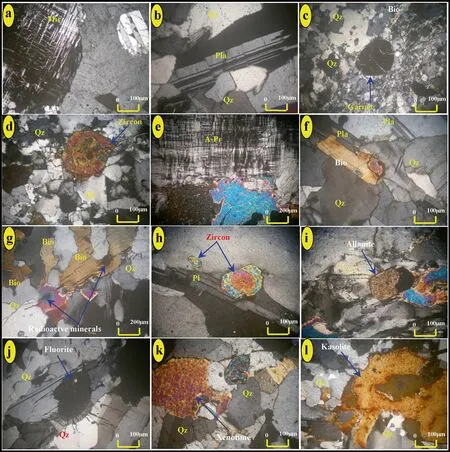
Fig.4 Photomicrographs of monzogranites (from a–d) and granitic pegmatites (from e–l) of studied area,CED,Egypt,clarifying: a Potash feldspars are represented by microcline and orthoclase perthite(C.N.),b Plagioclase(Pl)exists as euhedral crystals and dislocated twin lamellae due to deformation (C.N.), c Garnet occurs as well-formed polygonal crystals associated with quartz (Qz) and biotite (Bio) (C.N.), d Zircon occurs as zoned crystals with metamectized core associated with quartz (Qz)(C.N.), e Megacrystal of antiperthite (A-Pr) enclosing plagioclase and microcline crystals (C.N.),f Plagioclase(Pl)characterized by albite twining associated with flake of biotite(C.N.),g Biotite(Bio)occurs as crystals of radioelements-bearing minerals surrounded by pleochroic haloes (C.N.), h Zoned crystal of zircon associated with plagioclase (Pl)(C.N.),i Allanite occurs as subhedral crystals(C.N.),j Fluorite occurring as a yellow amorphous radioactive mineral(C.N.),k Xenotime occurs as well-formed crystals interference color associated with quartz (Qz) (C.N.),and l Secondary uranium minerals (Kasolite) are represented as radiated minerals associated with quartz (Qz) (C.N.)
4.3 Mineralogical investigations
Analysis of the heavy minerals associated with the investigated granitic pegmatites by scanning electron microscope (SEM) and back-scattered electron imaging (BSE)revealed the existence of the following radioactive and non-radioactive minerals and can be grouped into:
4.3.1 Uranium and thorium minerals
4.3.1.1 Kasolite (Pb,UO3,SiO2,H2O)Kasolite was found as compact and brownish-yellow grains separated from granitic pegmatites of the studied area.It is considered a rare alteration product of other uranium minerals.It is a hydrated silicate of lead and hexavalent uranium and is the only uranyl silicate with lead as its major cation and formed by the circulating meteoric water enriched with Pb and silica leached from the metamict U-bearing minerals.It is characterized by its crystal habit and luster from the other uranium silicates.The ESEM-EDX pattern of the kasolite (Fig.5a) revealed that the Pb (34.01 wt%),U(42.12 wt%),and Si (14.83 wt%) are the dominant components.
4.3.1.2 Thorite (Th SiO4)Thorite is found as an accessory mineral in various rock types,particularly pegmatites,granites,and hydrothermal deposits.It is metamicted in most cases owing to its radiogenic nature.It is a highly radioactive mineral due to the presence of thorium as a common radioactive element and uranium as a minor component.The investigated thorite is characterized by prismatic habit,brownish-black in color,and shows glassy luster that reflects their freshness.It usually contains ThO2ranges between 35%and 80%with minor uranium content.The ESEM-EDX pattern of the thorite (Fig.4b) revealed that the Th(55.99 wt%),U(9.34 wt%),and S(15.96 wt%)and usually accompanied by the allanite mineral (Fig.5b).
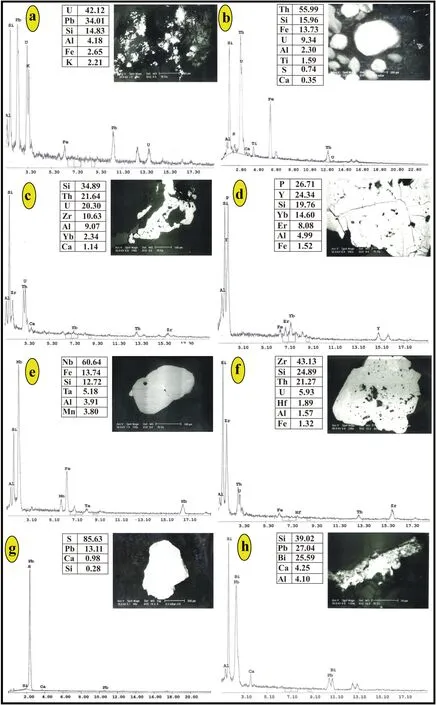
Fig.5 Micrograph and EDX chart by ESEM for a Kasolite,b Thorite, c Uranothorite,d Xenotime, e Columbite,f Zircon, f, g Galena and h Bismuth from the granitic pegmatites of the studied area,CED,Egypt
4.3.1.3 Uranothorite(Th,U)SiO4Uranothorite occurs as massive,reddish-brown to brownish-black and of glassy luster and sometimes greasy due to the alteration effect.It resembles the thorite except for its U3O8content that exceeds 5%with other minor constituents as P,Ca,and Fe(Fig.5c).It is essentially composed of ThO2(49%–75%),SiO2(up to 20%),and U (up to 10%).Mg,Ca,alkalis,Fe,Ce,P,Ti,Ta,Zr,Sn,Al,Y,Fe3+and Pb elements may be found in small to minor contents (Heinrich 1958).The ESEM-EDX pattern of the uranothorite (Fig.5c) revealed that the Th(21.64 wt%),U (20.3 wt%),Al(9.07 wt%),Zr(10.63 wt%),and S (34.89 wt%).
4.3.2 U,Th and REE-bearing accessory minerals
4.3.2.1 Xenotime (YPO4)Xenotime crystals are comparable to zircon and may easily be confused with the duller luster.Uranium and/or other rare elements such as erbium,thorium,ytterbium and zirconium are found as traces in xenotime replacing the yttrium.It is recorded in the granitic pegmatites of the studied area.The investigated xenotime mineral grains are euhedral to subhedral crystals with brown color but also gray with vitreous to resinous luster.The ESEM-EDX pattern of the xenotime (Fig.5d)revealed that the P (26.71 wt%),Y (24.34 wt%),Si(19.76 wt%),Yb (14.60 wt%) and Er (8.08 wt%).
4.3.2.2 Columbite [(Fe,Mn) (Nb,Ta)2O6)]Columbite is the most widespread niobium mineral in the granitic pegmatites and makes for an important ore of the industrially useful metal and also called niobite.Black radioactive columbite has been recorded in the studied granitic pegmatites and occurs as black colored anhedral crystals with sub-metallic to resinous luster having dark red to black streak.It is associated with xenotime and iron-oxides on the periphery of the pegmatitic body reflecting the enrichment of both Li and P in the source liquid.It is essentially composed of Fe-columbite (Ta <Nb,Mn <Fe)as indicated from the ESEM analysis.The ESEM-EDX pattern of the columbite (Fig.5e) revealed that the Nb(60.64 wt%),Fe (13.74 wt%),Si (12.72 wt%),Ta(5.8 wt%) and Mn (3.80 wt%).
4.3.2.3 Zircon(ZrSiO4)Zircon grains are encountered in the monzogranite and the granitic pegmatites of the studied area.Deer et al.(1992) and(Pupin and Turco 1979) stated that the rounding shape of zircon can take place in igneous rocks by magmatic adsorption and corrosion of the grains due to the metasomatism.The euhedral elongated prismatic habit of the zircon suggests the high fluid contents of its source magma and is considered a function of the temperature and the degree of zirconium super-saturation in the liquid.It is extremely resistant to chemical and physical weathering.The studied zircon grains have euhedral form mostly rounded grains with yellow to reddish-brown and sometimes colorless to pale yellow,with most transparent.The ESEM-EDX pattern of the zircon (Fig.5f) revealed that the Zr (43.13 wt%),Th (21.27 wt%),Si (24.89 wt%),and U (5.93 wt%).
4.3.3 Non-radioactive minerals
4.3.3.1 Galena (PbS)Galena is the most important source mineral for lead.Galena forms in hydrothermal vein deposits of a high-temperature origin.It is recorded in the granitic pegmatites and monzogranites of the studied area.Its color is lead to silver grey with metallic luster.The ESEM analysis of galena (Fig.5g) shows that,galena consist essentially of S (85.63 wt%) and Pb (13.11 wt%).
4.3.3.2 Bismuth (BiS)Bismuth sulfosalts are typical accessory minerals in the product of hydrothermal veintype mineralization and occur as subhedral to anhedral grain.The recorded bismuth has brittle metal with a silvery-white color.The ESEM analysis of bismuth (Fig.5h)shows that bismuth consists essentially of Bi (25.59 wt%),Pb (25.59 wt%),and Si (39.02 wt%).
4.4 Geochemistry of granitic pegmatites and monzogranites
The general characteristics of the studied granitic rocks and associated pegmatites depend on the behavior and distribution of the major oxides,trace elements,and rare earth elements (Tables 1,2 and 3).
4.4.1 Geochemistry of major oxides and trace elements
The compositions of the major oxides for the studied pegmatites show the nature of granite for these rocks and their advanced degree of magmatic evolution.The granitic pegmatite samples have high concentrations of SiO2(mean.74.74 wt%),Na2O (mean.5.48 wt%) and K2O(mean.4.58 wt%).Other major oxides are comparatively stable with Al2O3(mean.13.11 wt%),TiO2(mean.0.02 wt%),MgO (mean.0.12 wt%),P2O5(mean.0.02 wt%)and MnO(mean.0.04 wt%)(Tables 1,2 and 3).In the primitive mantle-normalized trace-element patterns (Fig.6a) of Sun and McDonough (1989),the concentrations of some trace elements show enrichments or depletions.The Abu Dob pegmatites reveal enrichments in Rb,Th,U,Pb,Nb,Nd and Zr and depletion in Ba,Ce,Sr,and Eu.The Kab El Rakeb pegmatites show enrichments in Rb,Th,U,Nb,Pb,Zr,and Lu and depletion in Ba,La,Sr and Eu.The Kadabora granites display enrichments in Rb,Th,U,La,Pb and Nd and depletion in Ba,Nb,Ce,Pr,Sr and Eu.This depletion was owing to the process of magmatic differentiation and alkali feldspars fractionation.Whilst,in the current study,this process not only contributed to the depletion but is also greatly reinforced by the late-stage melt-fluid interaction.The granitic pegmatites under investigation may be categorized as A Niobium–Yttrium–Fluorine family (NYF-type),according to the geochemistry of trace elements.
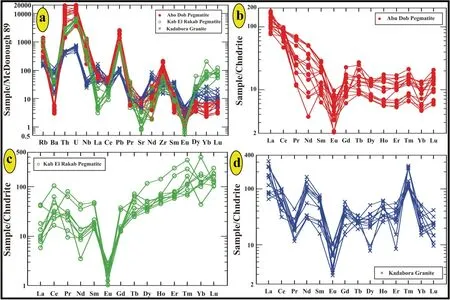
Fig.6 a Primitive mantlenormalized multi-elements patterns of the pegmatites and monzogranites samples (Sun and McDonough 1989),b Chondrite-normalized REE patterns for Abu Dob pegmatite samples, c Kab El Rakeb pegmaites samples and d Kadabora monzogranites samples (after Taylor and McLennan 1985).Symbols as shown in figures
4.4.2 Geochemistry of REEs
Geochemistry of Rare earth elements (REEs) for the investigated monzogranites and granitic pegmatites(Tables 1,2 and 3) reveal that the overall REEs ranges between 159.34 and 329.15 ppm for the monzogranites,from 115.47 to 200.34 ppm for Abu Dob pegmatites and from 102.70 to 341.66 ppm for Kab El Rakeb pegmatites concluding that,such granitic pegmatites are enriched with REEs compared to the international range (250–270 ppm)of Hermann (1970).The total in light rare earth elements(∑LREES) in the monzogranites range from 118.29 to 278.81 ppm with average 198.88 ppm,for Abu Dob pegmatites,it ranges from 96.08 to 182.89 ppm with an average 147.05 ppm and for Kab El Rakeb pegmatites,it ranges from 30.02 to 159.17 ppm with average 63.58 ppm.Whilst,∑HREEs(total in heavy rare earth elements)range from 32.68 to 64.27 ppm with an average 47.52 ppm in the monzogranites,from 8.45 to 22.88 ppm with an average 15.16 ppm in the Abu Dob pegmatites and from 69.08 to 182.49 ppm with an average 104.87 ppm in Kab El Rakeb pegmatites.
The normalized REEs patterns relative to chondritic values of Taylor and McLennan (1985) (Fig.6b,c and d),show enrichments in ∑LREEs than ∑HREEs with negative Eu anomaly for Abu Dob pegmatites,strong enrichment in∑HREEs than the ∑LREEs also with negative Eu anomaly for Kab El Rakeb pegmatites and show enrichment in∑LREEs and low ∑HREEs contents with strong negative Eu anomaly for Kadabora granites.These negative anomalies signify considerable metasomatism and fractionation.
4.4.3 REE tetrad effect
In geochemistry,the expression‘tetrad effect’indicates the subdivision of the 15 lanthanide elements into four (4)categories in a chondrite-normalized distribution pattern:(1)La–Ce–Pr–Nd,(2)Pm–Sm–Eu–Gd,(3)Gd–Tb–Dy–Ho and (4) Er–Tm–Yb–Lu,and each group forms a smooth convex (M-type) or concave (W-type) pattern.The Lanthanide tetrad effect indicates that the characteristics of lanthanide compounds are not a smooth function of atomic number (Masuda et al.1987).Gadolinium (Gd) is mutual among second and third groups of tetrads (Monecke et al.2002).Tetrad effect was recognized gradually,predominately for granite rocks that have undergone high levels of fractional crystallization,hydrothermal alteration and mineralization (Zhao et al.1993;Lee et al.1994;Bau 1996;Irber 1999).Tetrad effect in highly evolved granitic systems may be owing to (1) fractional crystallization during igneous crystallization (Monecke et al.2002),(2)fluid–melt interaction during crystallization of the silicate melt,(3)hydrothermal alteration during hydrothermal fluid rock interaction,and(4)weathering after granite formation(Takahashi et al.2002).Masuda et al.(1987) categorized the tetrad effect into two types,M-and W-type(M-type in solid sample as residues and W-type in the interacting fluids as extract).The tetrad effect results were computed using Irber’s (1999) quantification method:
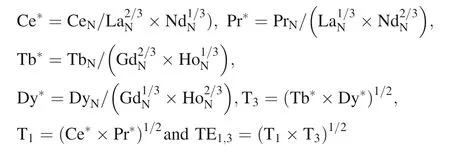
The tetrad effect of REE was essentially noted in late magmatic differentiation related to strong hydrothermal interactions or deuteric alteration (Masuda et al.1987;Monecke et al.2002).Samples with TE1.3<1.1 are used for an REE pattern without a tetrad effect.The tetrad effect is visible at TE1.3>1.1 (M-shaped pattern reveals when TE1.3>1.1 while,W-shaped shows when TE1.3<0.9).The calculated TE1,3values for the monzogranites are ranging from 0.23 to 0.68,for Kab El Rakeb pegmatites ranging from 0.76 to 3.42 and for Abu Dob pegmatites are ranging from 0.95 to 1.51 (Tables 1,2 and 3).Consequently,the REE patterns of Chondrite-normalized for the investigated monzogranite have TE1,3values less than 1.1,so they do not show tetrad effect while,the investigated granitic pegmatite samples indicate M-type pattern(Fig.6b,c),where the values of TE1.3are more than 1.1(Tables 1,2 and 3).
4.5 Distribution of radioelements in different rock types
Several representative samples from the study rock types are radiometrically measured by using well-calibrated and high-sensitive model RS-230 spectrometer.These types include the monzogranites and granitic pegmatites of G.Um Lassaf-Abu Dob-Um Atelia-Kadabora-Kab El Rakeb area (LDAK).The target is to define their contents(ppm)of eU,eTh and K.The ratios;eU/eTh,eTh/eU were calculated as well as eU–(eTh/3.5) ratio in order to test their radioactive equilibrium which would help to divine the type of U-migration and the origin of mineralization.The mean values of eU,eTh,K,eTh/eU and eU/eTh of studied rocks are listed in (Table 4).The field spectrometric measurements showed localization of spectrometric anomaly associated with the granitic pegmatites intruded in monzogranites.The eU value ranges from 1.3 to 57.4 ppm(av.11.87 ppm),eTh from 3.60 to 243.0 ppm (av.32.98 ppm),eU/eTh from 0.03 to 1.80(av.0.42 ppm),and eTh/eU from 0.55 to 33.75 (av.3.91 ppm),in Kadabora granites.According to Clark et al.(1966) and Rogers and Adams (1969),Kadabora granitic rocks are enriched in uranium.The eU value of Abu Dob pegmatites ranges from 1.0 to 208.4 ppm,(av.67.61 ppm),eTh from 5.5 to 998.6 ppm (av.271.69 ppm),eU/eTh from 0.05 to 1.05(av.0.29 ppm),and eTh/eU from 0.95 to 21.02 (av.4.13 ppm).
The radiometric investigation indicates that the concerned pegmatites of Kab El Rakeb area are comparatively enriched in eU and eTh compared to their hosting granites.The eU reaches up to 316 ppm (av.72.80 ppm),the eTh reaches up to 1367.2 ppm (av.353.36 ppm),the eU/eTh reaches up to 12.33(av.0.43 ppm),and the eTh/eU reaches up to 41.14(av.7.60 ppm).These averages are greater than those recorded for the Egyptian uraniferous pegmatite(respectively,33 and 28 ppm for U and Th).This indicates strong post-magmatic uranium enrichment in the pegmatitic melt.This could be supported by a high concentration of uranium in accessory minerals (e.g.,zircon,monazite,and radioactivebearing mineral (e.g.,uranothorite,thorite) and adsorbed mostly by iron oxides (Ali et al.,2008).
4.6 Uranium and thorium behavior in the studied rock types
Thorium is generally three times greater abundant than uranium with regards to magmatic conditions,i.e.,the eTh/eU ratio is generally around 3(chondritic ratio).If this ratio is fractionated,i.e.,becomes above or below 3.5 a process of U loss or gain could be anticipated.If the ratio is always around 3.5,the uranium and thorium are proposed to be incorporated within magmatically formed accessory minerals such as zircon,monazite,allanite,apatite,etc.The eTh/eU ratio is a very essential geochemical index for U migration.In this study,the average of eTh/eU ratio for the monzogranites have almost chondritic values (eTh/eU ratio=3.91) (Table 4).Furthermore,the eTh/eU ratio for both pegmatites of Abu Dob and Kab El Rakeb area,the eTh/eU are averaging 4.13 and 7.62,respectively(Table 4),are greater than the chondritic value denominating addition of Th.This phenomenon has previously been assured mineralogically as these pegmatites compile radioactive minerals such as uranothorite,thorite and a considerable amount of zircon beside fluorite and apatite as accessory minerals.
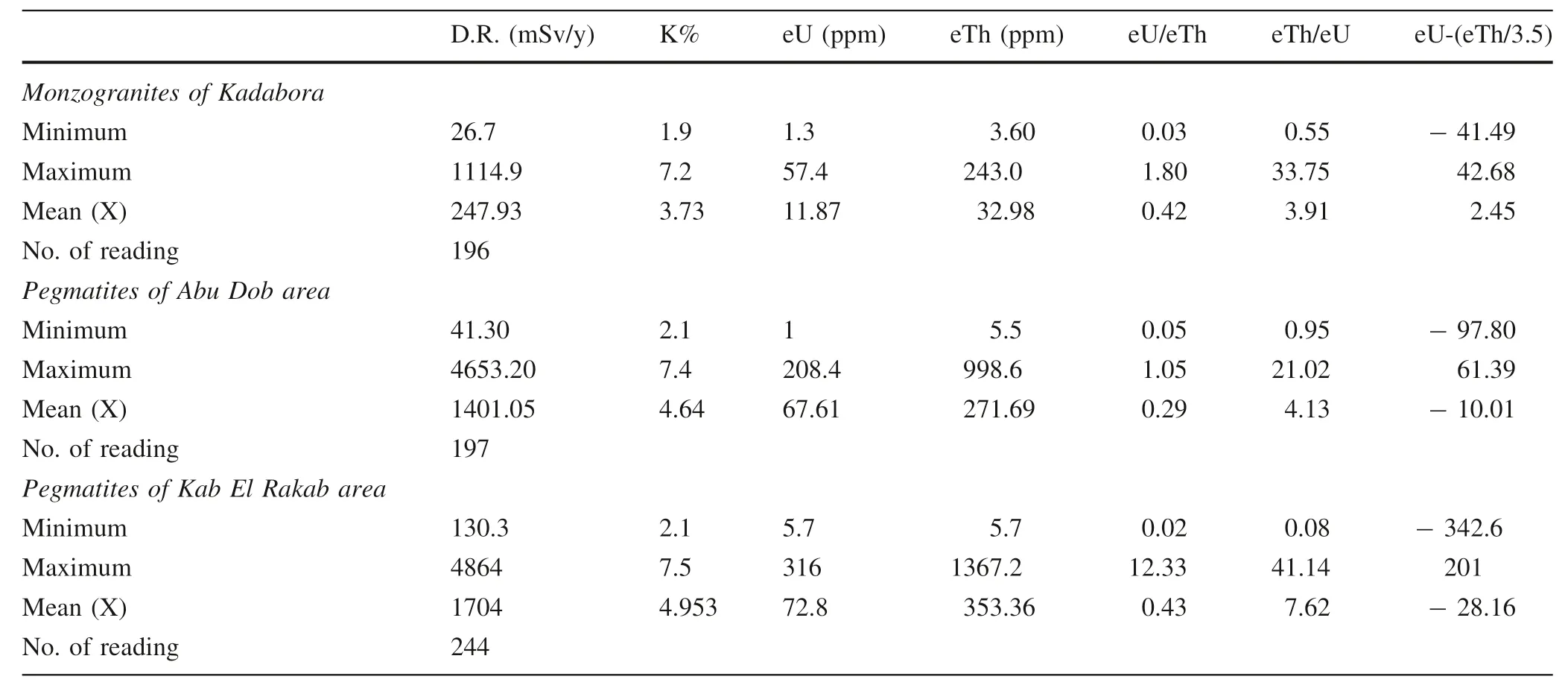
Table 4 Summary of the statistics for the surface distribution of the three radioelements K,eU,eTh and their ratios for monzogranites and pegmatites of G.Um Lassaf-Abu Dob-Um Atelia-Kadabora-Kab El Rakeb (LDAKK) areas,CED,Egypt
5 Discussion
5.1 Typology,magma type,tectonic setting and petrogenesis
When plotted on the Na2O+K2O versus SiO2diagram of Middlemost(1989),the studied samples of Kadabora fall in the field of the granite but Kab El Rakeb pegmatites are plotted in the Alkali feldspar granite field except for onesample of Abu Dob and one sample of Kab El Rakeb fall in the field of granite (Fig.7a).When plotted on the Na2-O+K2O versus SiO2diagram of Le Maitre et al.(1989),all the studied samples are plotted on the field of granite.By using the Molar Al2O3/(CaO+Na2O+K2O) versus Al2O3/(Na2O+K2O) diagram of Maniar and Piccoli(1989) and A/CNK versus SiO2diagram of Yuhara et al.(2003);the samples of the studied rocks are characterized as peralkaline to metalumainous type (Fig.7c,d).The Na2O versus K2O diagram of Chappell and White (1974)shows that all the studied samples are plotted in I-type field except two samples of kadabora granites (Fig.7e).
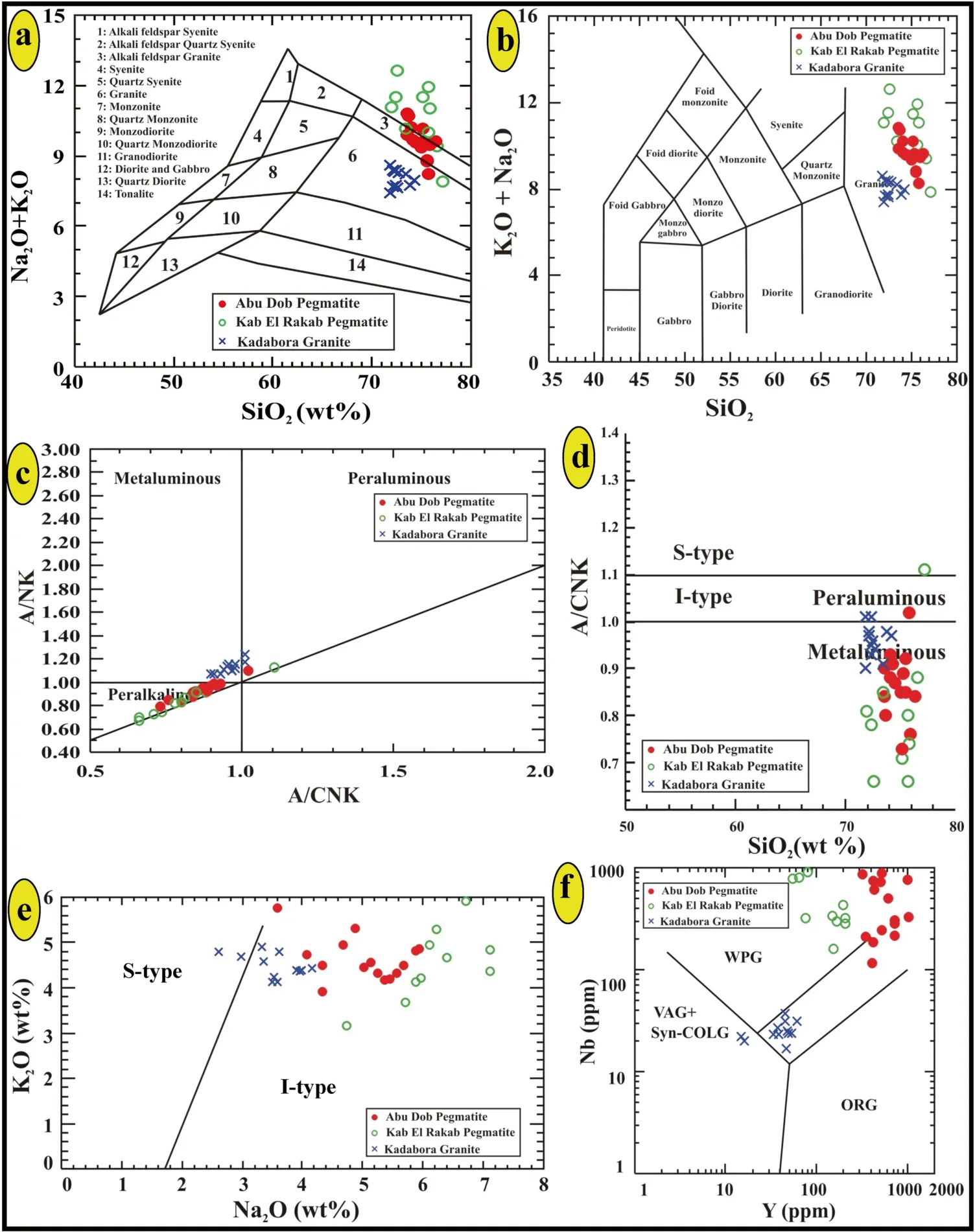
Fig.7 a Na2O+K2O versus SiO2 variation Diagram after(Middlemost,1989), b Total alkali (Na2O+K2O) versus SiO2 diagram after (Le Maitre et al.1989), c Molar Al2O3/(CaO+Na2O+K2O) versus Al2O3/(Na2O+K2O diagram after(Maniar and Piccoli 1989),d A/CNK versus SiO2 Diagram after (Yuhara et al.2003), e Na2O–K2O discrimination diagram for the studied samples after (Chappell and White 1974) and f Y (ppm)versus Nb (ppm) diagram after(Pearce et al.1984),whereas the fields are WPG within plate granite, ORG ocean ridge granites, VAG volcanic arc granites and Syn-COLG Syn-Collision granites.Symbols as shown in figures
When plotted on the Y versus Nb and Rb versus(Nb-Y)diagrams of Pearce et al.(1984),all the studied samples are plotted in the field of within plate granites (WPG),except for two samples of the Kadabora granites(Figs.7f and 8a).The Al2O3 versus SiO2diagram of Maniar and Piccoli(1989) shows that the studied samples plot on the postorogenic granite field (POG) (Fig.8b).
The behavior of Rb,Sr,and Ba elements in granitic system is very useful to infer the partial melting or fractional crystallization of granitic rocks.This behavior is strongly controlled by K-feldspar,plagioclase and mica as the ratio K/Rb usually decreases with increasing magmatic fractionation so it can be used as a petrogenetic indicator.When plotted on the Rb versus Sr binary diagram of Condi(1973);the studied samples are plotted on the field of depth >30 km showing the depth at which the granite crystallized (Fig.8c).The K/Rb*10,000 versus Rb binary diagram (Fig.8d),shows that the most significant process during magmatic differentiation was crystal fractionation.The water–vapor pressure and the temperature isotherms at which the studied granites were generated can be determined by using the normative Qz-Ab-Or ternary diagrams(Tuttle and Bowen 1958,Luth et al.1964)(Figs.8e and f).The water–vapor pressures of the monzogranites and the granitic pegmatites were at about 3 K-bar(2–5 K-bar) and(2–10 K-bars)and temperature ranging from 750 to 840 °C revealing that they were probably formed at moderate levels in the crust.K2O–SiO2diagram(with partial melting fields of different rock sources for the investigated samples after (Gerdes et al.2000) (Fig.8g) shows that the studied rocks were formed by the partial melting of metagreywackes found in the Arabian Nubian Shield (ANS)deep crust.
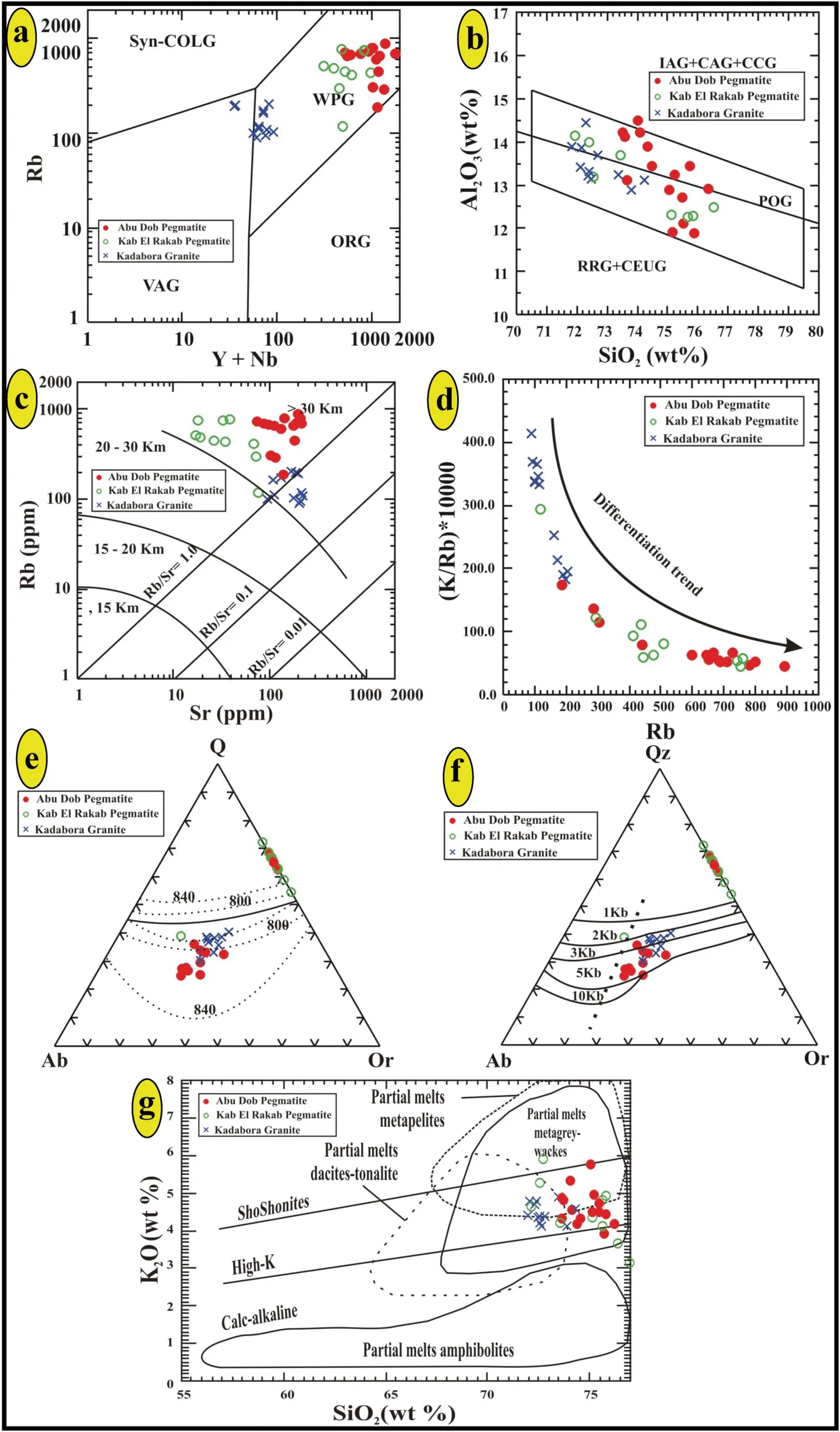
Fig.8 a Rb versus Y+Nb diagram after (Pearce et al.1984),whereas the fields are WPG within plate granite, ORG Ocean ridge granites, VAG volcanic arc granites, Syn-COLG Syn-Collision granites,b SiO2–Al2O3 diagram after(Maniar and Piccoli 1989),c Rb versus Sr diagram after (Condi 1973), d K/Rb vs.Rb binary diagram, e Normative Qz–Ab–Or ternary diagram.The dashed line represents the variation in position of the minimum melting points in the granite system at different water vapor pressures after Tuttle and Bowen (1958) and Luth et al.(1964), f Normative Qz–Ab–Or Isobaric equilibrium ternary diagram after (Tuttle and Bowen 1958) and g K2O–SiO2 diagram.Fields of partial melts of different rock sources for the studied samples after (Gerdes et al.2000).Symbols as shown in figures
5.2 Uranium and thorium radioactivity
The wide ranges of eU/eTh ratio of granitic pegmatites(0.02–12.33) and eTh/eU ratio (0.08–41.14) indicate that they have a very high U potential mobilization and its ratios are not normal and form anomalous zones.
The eTh/eU diagram of the studied monzogranite and their associated pegmatites (Figs.9a,10a and 11a) shows an enrichment of uranium where the highest eU and eTh values are for the granitic pegmatite samples of G.Kab El(Fig.11a).Most of the samples are in between 4.0 and 5.0 eTh/eU ratio with a simultaneous increase in both eU and eTh.In the original rock,uranium remained relatively immobile.According to this diagram,the radioactivity increases gradually during magmatic fractionation,but the ratio changes due to different alteration processes (Heikal et al.2019).The eU/eTh versus eU diagram(Figs.9b,10b and 11b),reveals a clear direct slope indicating an enrichment of hydrothermal U.Thus,various processes of alteration played an important role in the mobilization of U.Furthermore,the eU/eTh versus eTh model (Figs.9c,10c and 11c) indicates a reverse relationship for the most plotted monzogranites and granitic pegmatites,if eTh increases at a constant eU,then eU/eTh will decrease,obviously,suggesting the vital role of hydrothermal solutions in redistribution process of these elements.Pagel(1982) concluded that,U and Th occur essentially in accessory minerals like thorite,monazite and zircon in the igneous rocks.Minerals with higher concentrations of U and Th perish their crystallinity owing to internal radiation damage being metamict more readily altered and hydrated,so that U would be easily leachable by circulating hydrothermal solutions.The majority of samples of the monzogranite and granitic pegmatite possess greater U concentrations (Table 4) than that of the hypothetical uranium distribution(Figs.9d,10d and 11d)and therefore,the mobilization gives positive values,which in turn indicates that U of these different studied rock types is migration (Cambon 1994).
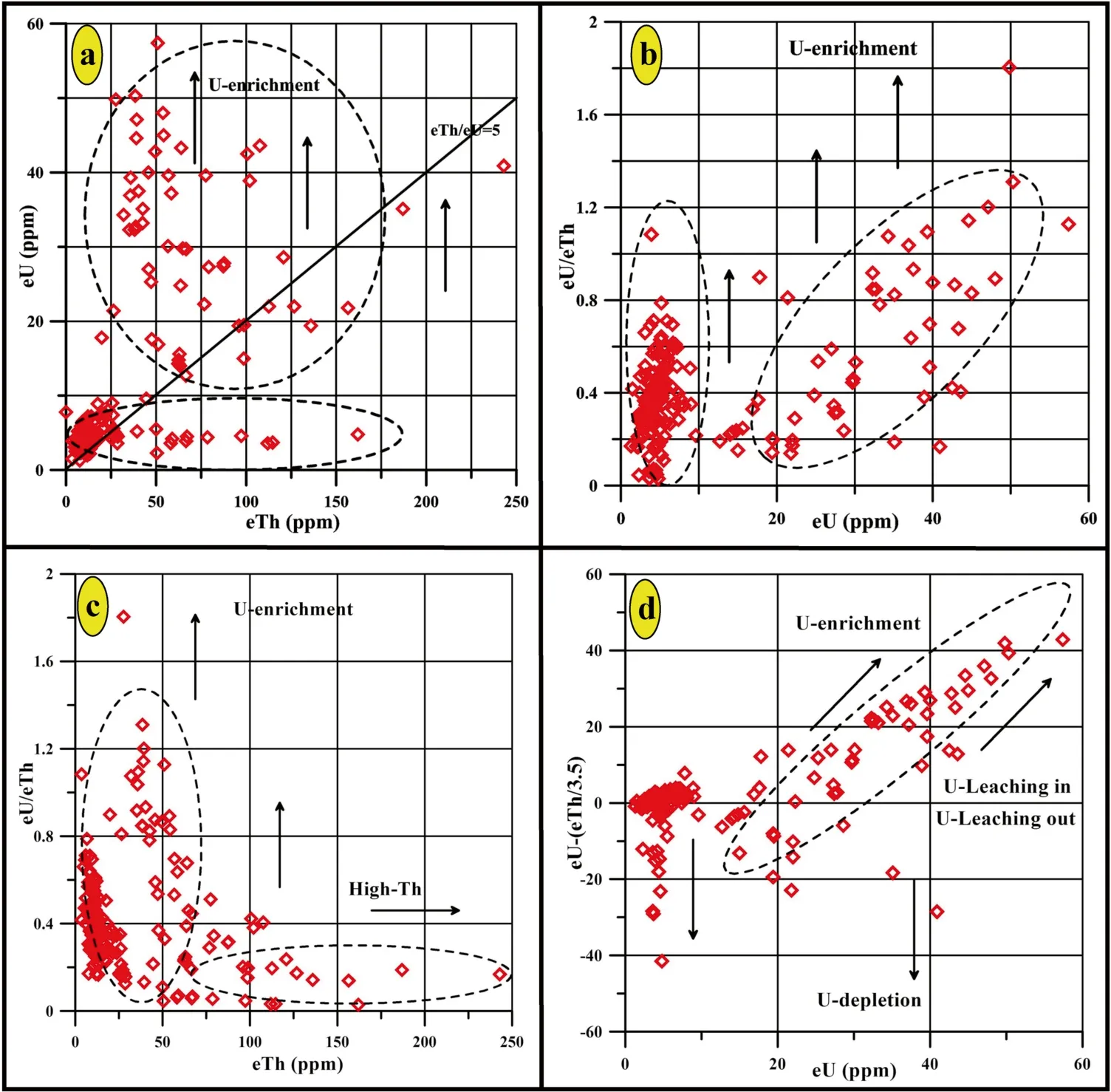
Fig.9 Radioactive elements plot for ground gamma-ray spectrometry measurements of monzogranites of G.Um Lassaf-Abu Dob-Um Atelia-Kadabora-Kab El Rakeb(LDAKK) area,CED,Egypt
Uranium is active according to the geochemical behavior and can be easily mobilized and migrated during its evolution under the action of oxygen from underground water and atmosphere whilst,Th is relatively stable in the oxidation zone.There are three major topics to identify the mobilization of both uranium and thorium that are discussed as follow:
5.2.1 eU/eTh ratio
The ratio of eU/eTh is a significant geochemical index for the mobilization of uranium (Naumov 1959).For granitic rocks,the eU/eTh ratio is usually around 0.33 (Stuckless et al.1977;Boyle 1982;El Nahas et al.2001;El Galy 2007).Even so,uranium enrichment may be determined by raising this proportion above 0.33 whilst,the uranium depletion may be defined by reducing the proportion by 0.33.The eU/eTh ratio,in Kadabora monzogranites varies from 0.03 to 1.80 (av.0.42);in Abu Dob pegmatites between 0.05 and 1.05(av.0.3)and from 0.02 to 12.33(av.0.43) in pegmatites of G.Kab El Rakeb (Table 4),proposing a greater degree of uranium mobilization and uranium enrichment.An increasing in eU/eTh ratio with U mobilization and post magmatic processes may be suitable economic standard for uranium enriched zones(Ibrahim et al.2001).
5.2.2 Equilibrium P-and D-factors
The P-factor can be calculated by dividing equivalent uranium(eU)and radium(Ra)(eU/Ra)(Hussein 1978)and D-factor(Uc/eU)is also calculated by dividing the uranium chemically (Uc) and radiometrically (Ur) (Hansink 1976).If the P-factor and the D-factor are higher than one,the addition of uranium is indicated.The less than one means the removal of uranium.The addition or removal of uranium is influenced by the alteration processes that disrupt the state of equilibrium.In this study,only D-factor is calculated (Table 5) shows that the studied monzogranites range from 1.02 to 1.90 with an average of 1.5,from 1.1 to 1.97 with an average of 1.54 in Abu Dob pegmatites,and from 1.0 to 1.92 with an average of 1.4 in G.Kab El Rakeb pegmatites.Accordingly,D-factor for all the studied rock types is greater than 1,indicating the addition of uranium(enrichment).
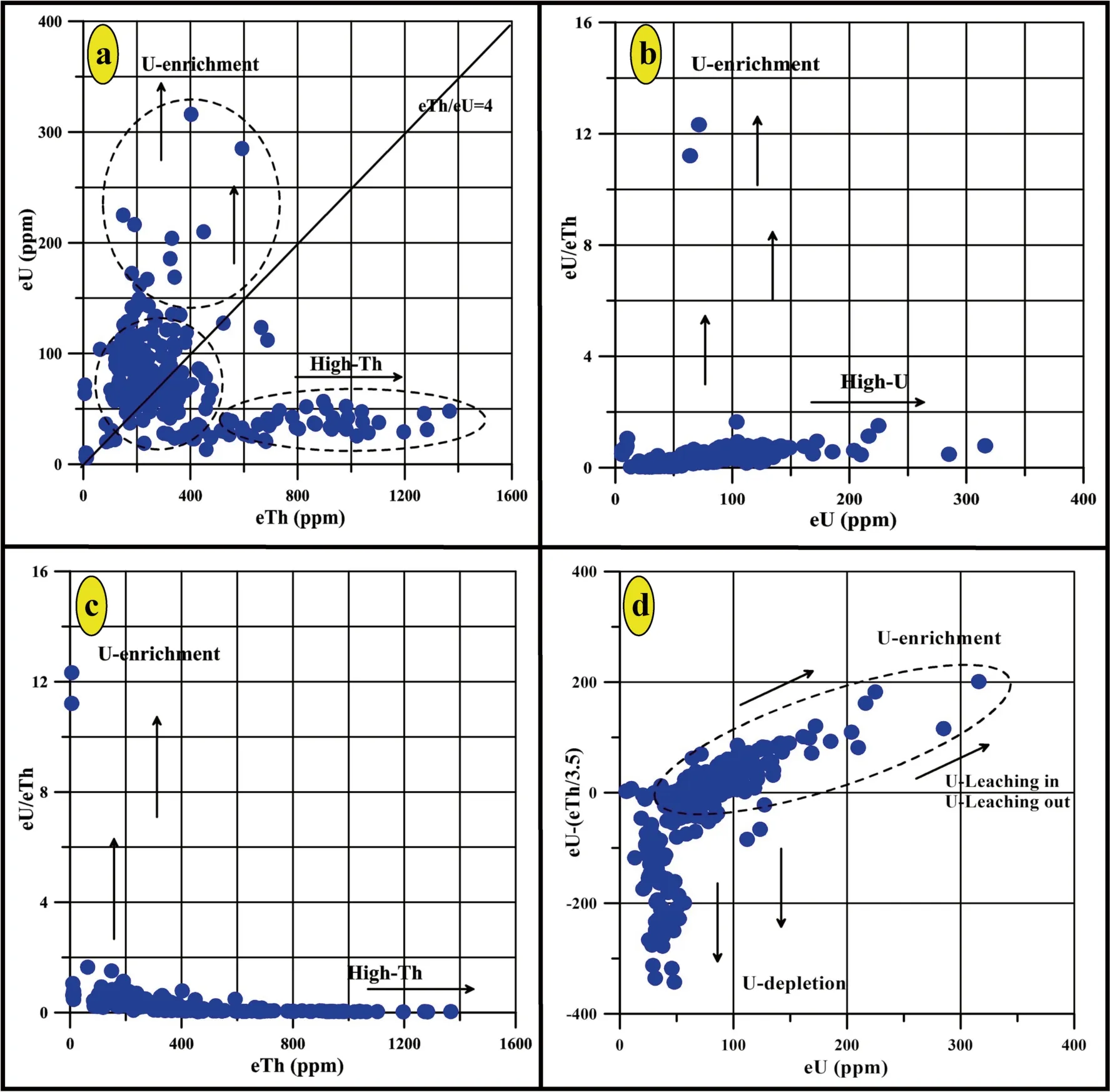
Fig.10 Radioactive elements plot for ground gamma-ray spectrometry measurements of pegmatites of G.Abu Dob area,CED,Egypt
5.2.3 Amount and type of uranium mobilization
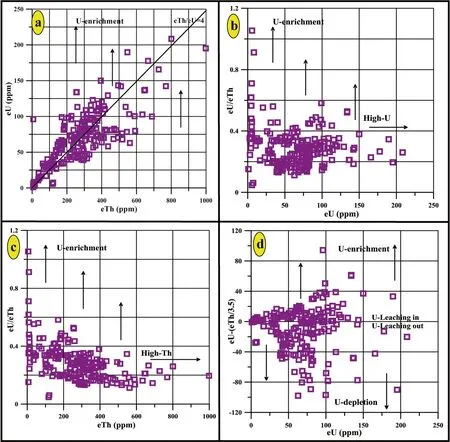
Fig.11 Radioactive elements plot for ground gamma-ray spectrometry measurements of pegmatites of G.Kab El Rakeb area,CED,Egypt
The equations of Beijing Research Institute of Uranium,China National Nuclear Corporation (CNNC1993)are used to calculate the amount of uranium mobilization and type (migration in or out) in the investigated rocks as follows:

whereas Uo is the original content of uranium,eTh is the mean of thorium content and eU/eTh is the mean of the regional eU/eTh ratio,Um is the amount of the mobilization of uranium,Up is the mean of the present uranium content and P is the rate of uranium mobilization.If Um >0:this means that U was gained or mobilized into the geologic body during late evolution (migration in).If Um <0:this means that U had been lost from the geologic body during late evolution(migration out).The data of Uo,Um,and P for different studied rock units are reported in(Table 6).The data indicate that the Um amounts are <0 in granitic pegmatites and monzogranites showing that,U was mobilized out from them(migration out),mostly to the stream sediments.
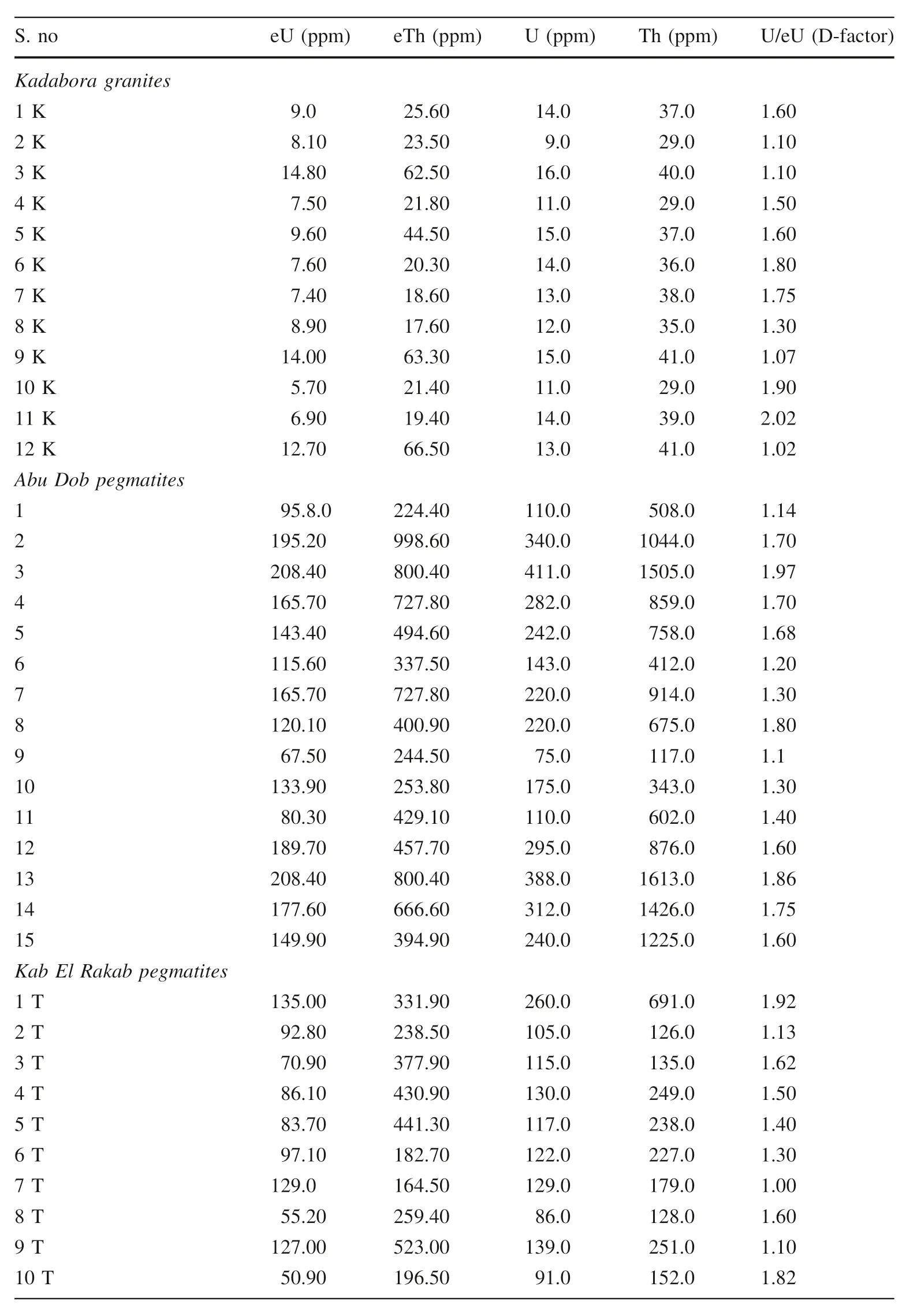
Table 5 Results of eU-eTh spectrometric measurements(ppm) and U-Th (ppm)chemical analyses in monzogranites and pegmatites,G.Um Lassaf-Abu Dob-Um Atelia-Kadabora-Kab El Rakeb area,CED,Egypt

Table 6 Average of the original uranium,the present uranium,the mobilized uranium and the uranium mobilization rate in the studied rocks of G.Um Lassaf-Abu Dob-Um Atelia-Kadabora-Kab El Rakeb areas,CED,Egypt
5.3 Origin of the uranium and thorium mineralization
Although thorium is more abundant than uranium in the Earth’s crust (Th is 3–4 times as U) but its chemical properties permit its easy movement or formation of secondary minerals after the original deposition.Consequently,the content of thorium minerals is small,if compared to those of uranium.Accordingly,the identified thorite and uranothorite(derivative of thorite when contains>5%U3O8)in the pegmatites of the studied area are only ascribed to the direct magmatic origin.On the other hand,the origin of the secondary uranium minerals identified in this study can be discussed and explained through several probable mechanisms such as,mobilization of labile uranium,U-mobilization from the oxidized primary uranium minerals,mobilization from accessory and refractory minerals and hydrothermal origin.
The physically bounded or adsorbed uranium on the surface of some minerals like Fe-oxides and biotite,may be remobilized either by the effect of transporting medium such as meteoric water that acquires slight acidity through the dissolved CO2and forming the weak H2CO3acid or by the effect of the moved hydrothermal solution along the macro-or micro-channels.Referring to the provisions of this mechanism in the acidic igneous rocks (the silica content,the alkaline affinity,the anomalous Th concentration,Zr-content,Th/U ratio and U/K ratio).The labile uranium in the investigated igneous rock varieties is reasonable to be excluded as a probable source for the identified secondary uranium minerals (Stuckless and Ferreira 1976;Watson 1979;Stuckless et al.1984).During the late magmatic stage,the presence of zircon,fluorite and apatite minerals associated with the radioactive minerals means that the hydrothermal fluids can push their uranium from the magma forming the granite itself.On the other hand,in the younger granites the existence of radioactive minerals in combination with hematite and deep violet fluorite suggests the hydrothermal epigenetic origin of this mineralization.
The pre-existing primary uranium minerals (uraninite)in which the uranium is found as U4+and keeps its stability and immobilization as the reducing environment continues.With the availability of the oxidizing conditions,the U4+oxidized into the hexa-valence form (U6+) and becomes easily mobile with the circulating fluids.Under the relevant conditions of the pH,Eh,temperature and concentrations of the other cations and anions in the carrier fluids,the secondary uranium minerals are formed.By the interaction of the circulating meteoric water or the hydrothermal fluids with the deformed accessory minerals,the U4+is oxidized to U6+and leached out then subsequently redeposited in near surface or at low temperature shear zones or even travels to the surroundings according to the available pathways forming the secondary uranium minerals(Simpson et al.1979).This model seems to be accepted in our case where the mineralogical study recorded the presence of metamict zircon in the investigated rocks.The original uranium of epigenetic source interacts with the hydrothermal solution forming the secondary uranium minerals in-situ without the further mobilization of uranium.
5.4 Genesis of pegmatite and mineralization
The probable genesis of granitic pegmatites and associated mineralization is given in (Fig.12).Petrographic studies indicated that the granitic pegmatites are essentially composed of quartz,plagioclase,k-feldspar (microcline),muscovite,biotite,and garnet.REE-bearing minerals zircon,monazite,xenotime,apatite,titanite,tourmaline and garnet are present in the granitic pegmatites and monzogranites as accessories.Based on the field observations,mineralogical assemblages,petrography and REE minerals,the pegmatites are late differentiated melts derived from the strongly peraluminous or meta-aluminous granite.Crystallization began at the border zone with plagioclase,quartz and muscovite.It continues in intermediate zones by crystallization of microcline and tourmaline.As crystallization proceeds,columbite-tantalite minerals in the inner zones of the pegmatite form in presence of both the fluid and the magma.Pegmatites are moderate to highly fractionated from parental sources as indicated by the presence of tourmaline,garnet and uranium mineralizations.In the beginning pegmatitic melt experienced an increase in Fe,Mg and Mn which led to the growth of large matrix garnets,owing to the crystallization of minerals rich in Si,Al,K and Na.In the final stage,with boron enrichment,the formation of tourmaline took place (Meshram and Shareef 2019).Most of the accessory minerals are reported in(Fig.12)and assorted according to the pegmatite evolution stage.Columbite–tantalite (Nb–Ta) is the main mineral group and grain size differ from the centimeter to decimeter scale.The mineralization is disseminated in pockets as aggregates of crystals in the core margin of the granitic pegmatites.They also occur sporadically in quartz margin as crystals on subcentimeter to centimeter scale.Zirconium(Zr)is also present in the core margin.It occurs as rounded or prismatic crystals in the pockets of pagmatites and is associated with Nb and Ta minerals forming the main ores in these pegmatites.Beryl (Be) is the main Be-mineral present and its grain size differs from centimeter to meter,it occurs as prismatic crystals and reveals different colors (blue,white,green,yellow and pink).It is found in the core and quartz margins associated with Cs,Nb,Ta and Ga minerals.Spodumene,lepidolite and Li are the main minerals of the Li-minerals group in the granitic pegmatites.Spodumene occurs as crystals or agglomerates in decimeter to meter dimensions,rarely forming individualized zones.Lepidolite is also the same as spodumen.The occurrence of these REEs containing minerals indicates peraluminous melt composition and volatile-rich fractionated nature of pegmatite from granitic source.REEs bearing mineral phases i.e.monazite,xenotime,uranothorite,thorite and zircon are present in pegmatite and monzogranite rocks,an early stage of igneous magmatic crystallisation.The Presence of euxenite-polycrase and uranopolycrase REE minerals indicates peraluminous and volatile-rich fractionated nature of pegmatite from granitic source.They belong to the NYF (Nb–Y–F) REE class and are interpreted to have formed in a late syn-to post-tectonic setting.
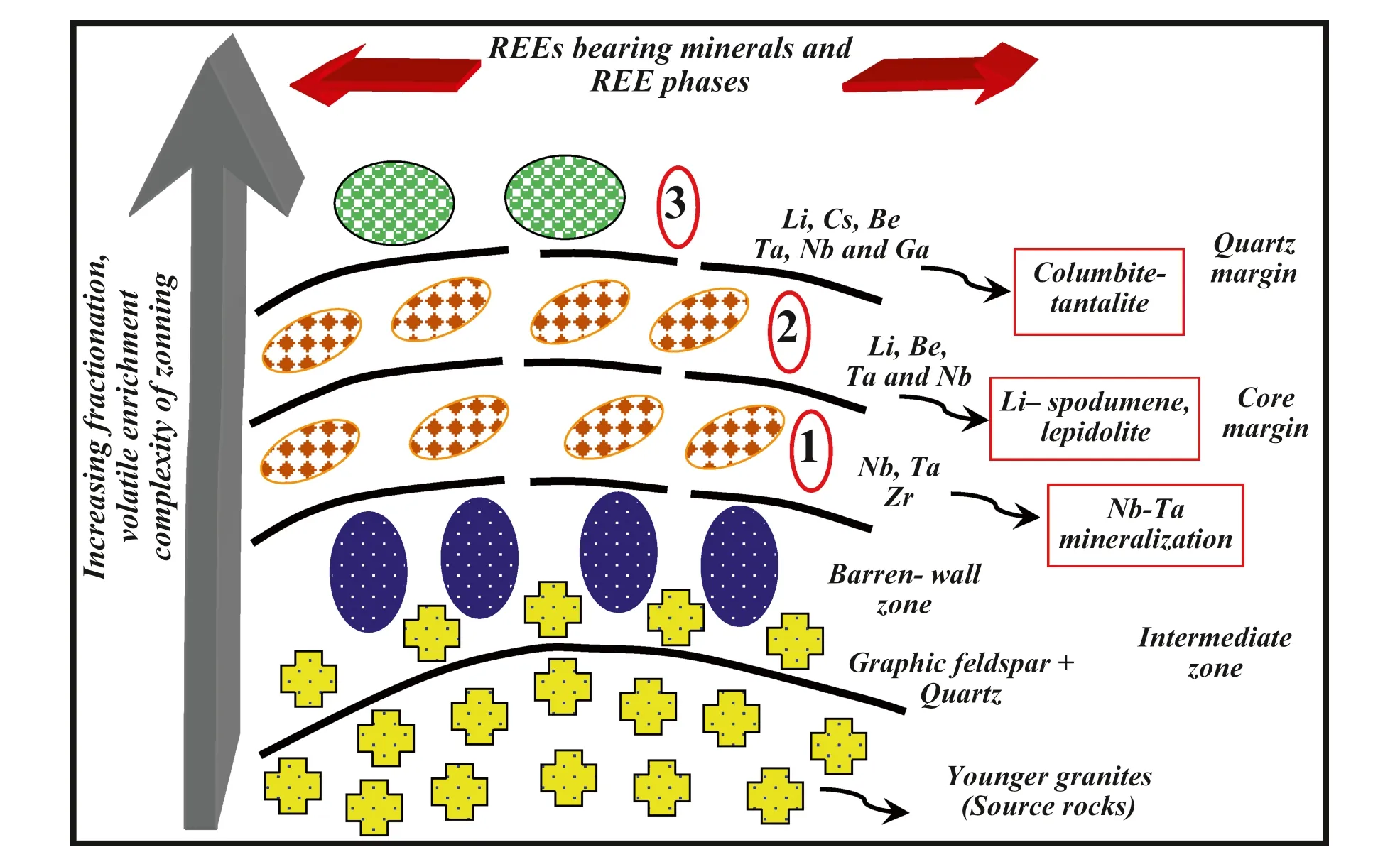
Fig.12 Schematic evolution of pegmatite and minerals in pegmatitic magma around G.Um Lassaf-Abu Dob-Um Atelia-Kadabora-Kab El Rakeb (LDAKK) area,CED,Egypt (modified after London 2008)
6 Conclusions
Gabal Um Lassaf-Abu Dob-Um Atelia-Kadabora-Kab El Rakeb area (LDAKk),which are situated in the central Eastern Desert of Egypt,represents a promising area for rare-metal and U mineralization.The granitic pegmatites occur as dykes,veins,and pockets.Petrographically,the granitic pegmatites and their hosting monzogranites indicate analogous mineral composition essentially of K-feldspar,albite,and quartz with a few biotite and muscovite.Mineralogically,the grantic pegmatites of the studied area are enriched with radioactive minerals like kasolite,uranothorite,and thorite,some radioelements-bearing accessory minerals such as;zircon,xenotim and columbite are also present.
Geochemically,the granitic pegmatites show an enrichment of the ∑LREEs and low ∑HREEs contents with strong negative Eu anomaly.They are clearly enriched in Pb,Rb,Th,U,Y,Zr and Nb compared to the host monzogranites.The spectrometric measurements of the studied granitic pegmatites reveal that,their equivalent uranium contents (eU) range from 67.61 and 316 ppm while their equivalent thorium contents (eTh) vary from 271.69 to 1367.2 ppm.Whilst,the eU contents vary from 1.3 to 57.4 ppm and the eTh contents range from 3.60 to 243.0 ppm in the monzogranites.Accordingly,this indicates strong post magmatic enrichment of uranium in the melt of the pegmatites.The high content of Th recorded in the studied granitic pegmatites is due to the presence of the primary Th radioactive mineral like (thorite).The uranium mineralization was found as syngenetic (from the magmatic uranium which incorporated in the accessory minerals) and/or epigenetic due to the hydrothermal activities.The high radioactivity is related to the accessory,secondary and refractory minerals besides the iron oxyhydroxides which play an essential role in capturing uranium from circulating solutions.The spatial distribution of uranium is lithologically and structurally controlled.
The geological inspections that have so far covered the area are inconvenient to expose the feasible economic potentialities of U and rare metal mineralization.So,the detailed exploratory researches are required to estimate the preserve of radioactive minerals as well as precious economic rate-metal mineralization.
AcknowledgementsThe authors sincerely thank Prof.M.H.Shalaby and Prof.M.E.Ibrahim for his valuable and constructive comments,NMA,Cairo,Egypt for their assistance in the field work.The authors would like to thank the anonymous reviewers for their comments that help improve this manuscript significantly.
杂志排行
Acta Geochimica的其它文章
- Variations of methane stable isotopic values from an Alpine peatland on the eastern Qinghai-Tibetan Plateau
- Quantifying aluminosilicate manganese release and dissolution rates across organic ligand treatments for rocks,minerals,and soils
- Concentration determination of gold nanoparticles by flame atomic absorption spectrophotometry
- Evaluating soil erosion by water in a small alpine catchment in Northern Italy:comparison of empirical models
- Pressure calibration and sound velocity measurement to 12 GPa in multi-anvil apparatus
- Olivine and Cr-spinel as indicators of the petrogenesis and partial melting conditions of the high-MgO ultramafic volcanic rocks from NW Ad Dhala Province—Yemen
